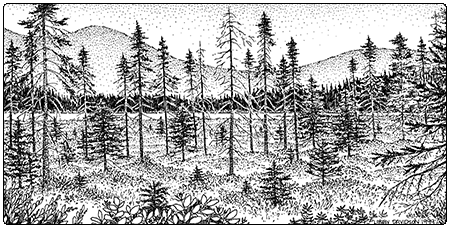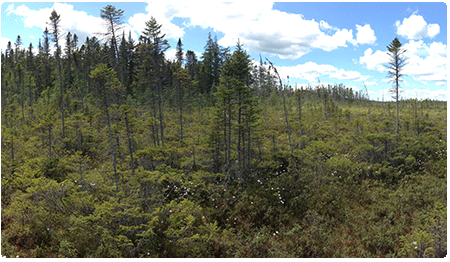Ecology and Physical Setting 
Spindly and scattered black spruce with tufted “lollipop” tops, dense heath shrubs, and spongy sphagnum mounds characterize these acidic, nutrient and mineral-poor peatlands. Vermont examples of this community type are generally less than 50 acres. Closely related communities cover extensive areas of the boreal landscape to our north, where they are often referred to as black spruce muskeg. In Vermont, Black Spruce Woodland Bogs are transitional between Dwarf Shrub Bogs and Black Spruce Swamps and often occur in association with one or both of these communities. This community may also occur in association with Poor Fens, and in these cases there may be slight mineral enrichment that alters the typical vegetation of the Black Spruce Woodland Bog.
Like Dwarf Shrub Bogs, Black Spruce Woodland Bogs occur as parts of larger peatland systems and occasionally in kettlehole basins. The poorly decomposed sphagnum and woody peat is generally deeper than three feet, and it may be more than ten feet deep. These organic soils are saturated throughout the year. Hummocks and hollows are well developed, but there is seldom any standing water in the moist hollows. Like Dwarf Shrub Bogs, Black Spruce Woodland Bogs are found in the colder regions of the state or in depressions that receive cold air drainage.
Vegetation

This woodland community has scattered, stunted black spruce trees that are usually less than 30 feet tall. In this peatland setting with a substrate low in oxygen and minerals, black spruce grows slowly, and many trees have a characteristic tufted top. These distinctive trees form an open canopy (25 to 60 percent cover). Black spruce dominates the tall shrub layer as well, although tamarack may also be present. Low heath shrubs are abundant, especially Labrador tea and leatherleaf, with lesser amounts of sheep laurel, bog laurel, blueberries, and rhodora, all mixed with small black spruce. In areas with slight mineral enrichment, one is more likely to find tall shrubs such as mountain holly, wild raisin, and winterberry holly. Highbush blueberry and black huckleberry may occur in warmer regions of Vermont.
Raised hummocks and low hollows are all carpeted by sphagnum moss, with the typical species zonation from hummock top to hollow bottom being Sphagnum fuscum, Sphagnum capillifolium, Sphagnum magellanicum, Sphagnum angustifolium, and Sphagnum fallax. Schreber’s moss is very common in this community, as is bog haircap moss. Small cranberry is typically present, as are Billings’ sedge, round-leaved sundew, hare’s tail cottongrass, and creeping snowberry.
Wildlife Habitat

spruce and tamarack. It causes odd growth patterns, called
witches brooms, on the host trees.
Black Spruce Woodland Bogs support many breeding birds. Some of the more common species include Lincoln’s sparrow, magnolia warbler, Nashville warbler, common yellowthroat, and olive-sided flycatcher. The rare birds breeding in Vermont’s Black Spruce Woodland Bogs are primarily species of the boreal north. Palm warblers are one of the first warblers to return to Vermont in the spring. They build their nests on hummocks under stunted black spruce trees. Other rare birds include yellow-bellied flycatcher, black-backed woodpecker, Canada jay, and boreal chickadee. The rare southern bog lemming and the more common masked shrew both prefer moist habitats like these bogs. There are several species of rare butterflies, dragonflies, and damselflies found in Black Spruce Woodland Bogs, most of which also occur in Dwarf Shrub Bogs.
Related Communities
- Dwarf Shrub Bog is an open peatland dominated by sphagnum moss and heath shrubs, with less than 25 percent cover of stunted black spruce or tamarack. These two communities often intergrade.
- Black Spruce Swamp is a forested swamp with greater than 60 percent cover of black spruce and other trees. Black Spruce Swamps may be slightly enriched through contact with mineral soils or runoff and have shallower, more decomposed organic soils than in Black Spruce Woodland Bogs.
Conservation Status and Management Considerations
Black Spruce Woodland Bogs are rare in Vermont and most of our examples are small. A number of good examples are conserved. This community is threatened by alterations in the surrounding watershed—such as clearcutting and development—that result in changes in the quality or quantity of surface water runoff. The vegetation and peat of Black Spruce Woodland Bogs is also susceptible to trampling. Boardwalks allow visitors to enjoy these remarkable places while protecting the integrity of the community.
Distribution/Abundance 
Black Spruce Woodland Bogs are found primarily in the cooler regions of Vermont. Closely related communities are widespread across boreal latitudes, and occur as far south as Pennsylvania and New Jersey.
Characteristic Plants
Trees
Abundant Species
Black spruce – Picea mariana
Occasional to Locally Abundant Species
Tamarack – Larix laricina
Shrubs
Abundant Species
Labrador tea – Rhododendron groenlandicum
Leatherleaf – Chamaedaphne calyculata
Sheep laurel – Kalmia angustifolia
Occasional to Locally Abundant Species
Bog laurel – Kalmia polifolia
Velvetleaf blueberry – Vaccinium myrtilloides
Low sweet blueberry – Vaccinium angustifolium
Rhodora – Rhododendron canadense
Small cranberry – Vaccinium oxycoccos
Creeping snowberry – Gaultheria hispidula
Black huckleberry – Gaylussacia baccata
Mountain holly – Ilex mucronata
Wild raisin – Viburnum nudum var. cassinoides
Winterberry holly – Ilex verticillata
Highbush blueberry – Vaccinium corymbosum
Black chokeberry – Aronia melanocarpa
Herbs
Occasional to Locally Abundant Species
Billings’ sedge – Carex billingsii
Round-leaved sundew – Drosera rotundifolia
Hare’s tail cottongrass – Eriophorum vaginatum
Pitcher plant – Sarracenia purpurea
Goldthread – Coptis trifolia
Three-leaved false Solomon’s seal – Maianthemum trifolium
Bryophytes
Abundant Species
Moss – Sphagnum magellanicum
Moss – Sphagnum fuscum
Schreber’s moss – Pleurozium schreberi
Occasional to Locally Abundant Species
Moss – Sphagnum angustifolium
Moss – Sphagnum fallax
Moss – Sphagnum capillifolium
Bog haircap moss – Polytrichum strictum
Bog broom moss – Dicranum undulatum
Rare and Uncommon Plants
White fringed orchis – Platanthera blephariglottis
Bog sedge – Carex exilis
Bog aster – Oclemena nemoralis
Dragon’s mouth – Arethusa bulbosa
Southern twayblade – Neottia bifolia
Mountain cranberry – Vaccinium vitis-idaea
Dwarf mistletoe – Arceuthobium pusillum
Few-seeded sedge – Carex oligosperma
Associated Animals
Masked shrew – Sorex cinereus
Nashville warbler – Oreothlypis ruficapilla
Magnolia warbler – Dendroica magnolia
Canada warbler – Cardellina canadensis
Common yellowthroat – Geothlypis trichas
Northern waterthrush – Parkesia noveboracensis
Yellow-rumped warbler – Setophaga coronata
Lincoln’s sparrow – Melospiza lincolnii
White-throated sparrow – Zonotrichia albicollis
Olive-sided flycatcher – Contopus cooperi
Rare and Uncommon Animals
Southern bog lemming – Synaptomys cooperi
Yellow-bellied flycatcher – Empidonax flaviventris
Black-backed woodpecker – Picoides arcticus
Spruce grouse – Falcipennis canadensis
Canada jay – Perisoreus canadensis
Rusty blackbird – Euphagus carolinus
Boreal chickadee – Poecile hudsonicus
Palm warbler – Setophaga palmarum
Bog copper – Lycaena epixanthe
Brown elfin – Callophrys augustinus
Jutta arctic – Oeneis jutta
Two-spotted skipper – Euphyes bimacula
Kennedy’s emerald – Somatochlora kennedyi
Forcipate emerald – Somatochlora forcipata
Delicate emerald – Somatochlora franklini
Sphagnum sprite – Nehalennia gracilis
Harlequin darner – Gomphaeschna furcillata
Places to Visit
Lake Carmi Bog, Lake Carmi State Park, Franklin, Vermont Department of Forests, Parks, and Recreation (VDFPR)
Moose Bog, Wenlock Wildlife Management Area, Ferdinand, Vermont Fish and Wildlife Department (VFWD)
Victory Bog, Victory Basin Wildlife Management Area, Victory (VFWD)
Peacham Bog, Groton State Forest, Peacham, VDFPR
Mollie Beattie Bog, Lewis, U.S. Fish and Wildlife Service
